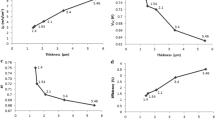Abstract
The dye-sensitized solar cell (DSSC) is a device for the conversion of visible light into electricity which uses the photoelectrochemical system that is made up of a semiconductor that is formed between a photosensitized anode and an electrolyte. It is based on the sensitization of wide bandgap semiconductors. The DSSCs are categorized as the solar cells of the next generation for their low manufacturing costs compared with the silicon type of solar cells. In DSSC, titanium dioxide (TiO2) is one of the suitable material used for nano-porous thin film since it has appropriate energy levels, high dye adsorption ability, and low cost, and it is easy to prepare. Extensive research on the photochemistry and photophysics of TiO2-based DSSCs has shown that the light-harvesting efficiency of TiO2 is influenced by its crystalline phase, particle size, as well as its surface area, dye affinity, and film porosity. In this research, we have focused on the dye and its effect on the light scattering of TiO2 particles and the best condition of TiO2 particles in order to improve solar energy conversion efficiency. The best condition for TiO2 particles, which were sintered at 450 °C for 60 min, resulted from the use of the spin-coating method. On the other hand, the best dye is anthocyanin (blueberry), and the best condition was to keep it for 6 h, at 21 °C, in a dark environment.
Access this chapter
Tax calculation will be finalised at checkout
Purchases are for personal use only
Similar content being viewed by others
References
Gratzel M (2005) Solar energy conversion by dye-sensitized photovoltaic cells. Inorg Chem 44:6841–6851
Saadoun L et al (2000) Synthesis and photocatalytic activity of mesoporous anatase prepared from tetrabutylammonium-titania composites. Mater Res Bull 35:193
O’Regan B, Gratzel M (1991) A low-cost, high-efficiency solar cell based on dye-sensitized colloidal TiO2 films. Nature 353:737
Odobel F, Blart E, Lagrée M et al (2003) Porphyrin dyes for TiO2 sensitization. J Mater Chem 13(3):502–510
Islam A, Sugihara H, Hara K et al (2001) Dye sensitization of nanocrystalline titanium dioxide with square planar platinum(II) diimine dithiolate complexes. Inorg Chem 40(21):5371–5380
Zhang D, Lanier SM, Downing JA, Avent JL, Lum J, McHale JL (2008) Betalain pigments for dye-sensitized solar cells. J Photochem Photobiol A 195(1):72–80
Wang H-H et al (2011) Preparation of nano-porous TiO2 electrodes for dye-sensitized solar cells. J Nanomater 2011(2011):7
Ito S et al (1999) Low-temperature synthesis of nanometer-sized crystalline TiO2 particles and their photoinduced decomposition of formic acid. J Colloid Interface Sci 216(1):59–64
Author information
Authors and Affiliations
Corresponding author
Editor information
Editors and Affiliations
Rights and permissions
Copyright information
© 2015 Springer Japan
About this paper
Cite this paper
Nuran, A., Daiki, M., Norsyafiq, M., Fujiki, A. (2015). Basic Research on the TiO2 Electrode and the Coloring Effect of Dye-Sensitized Solar Cell. In: Ab. Hamid, K., Ono, O., Bostamam, A., Poh Ai Ling, A. (eds) The Malaysia-Japan Model on Technology Partnership. Springer, Tokyo. https://doi.org/10.1007/978-4-431-54439-5_36
Download citation
DOI: https://doi.org/10.1007/978-4-431-54439-5_36
Published:
Publisher Name: Springer, Tokyo
Print ISBN: 978-4-431-54438-8
Online ISBN: 978-4-431-54439-5
eBook Packages: EngineeringEngineering (R0)




